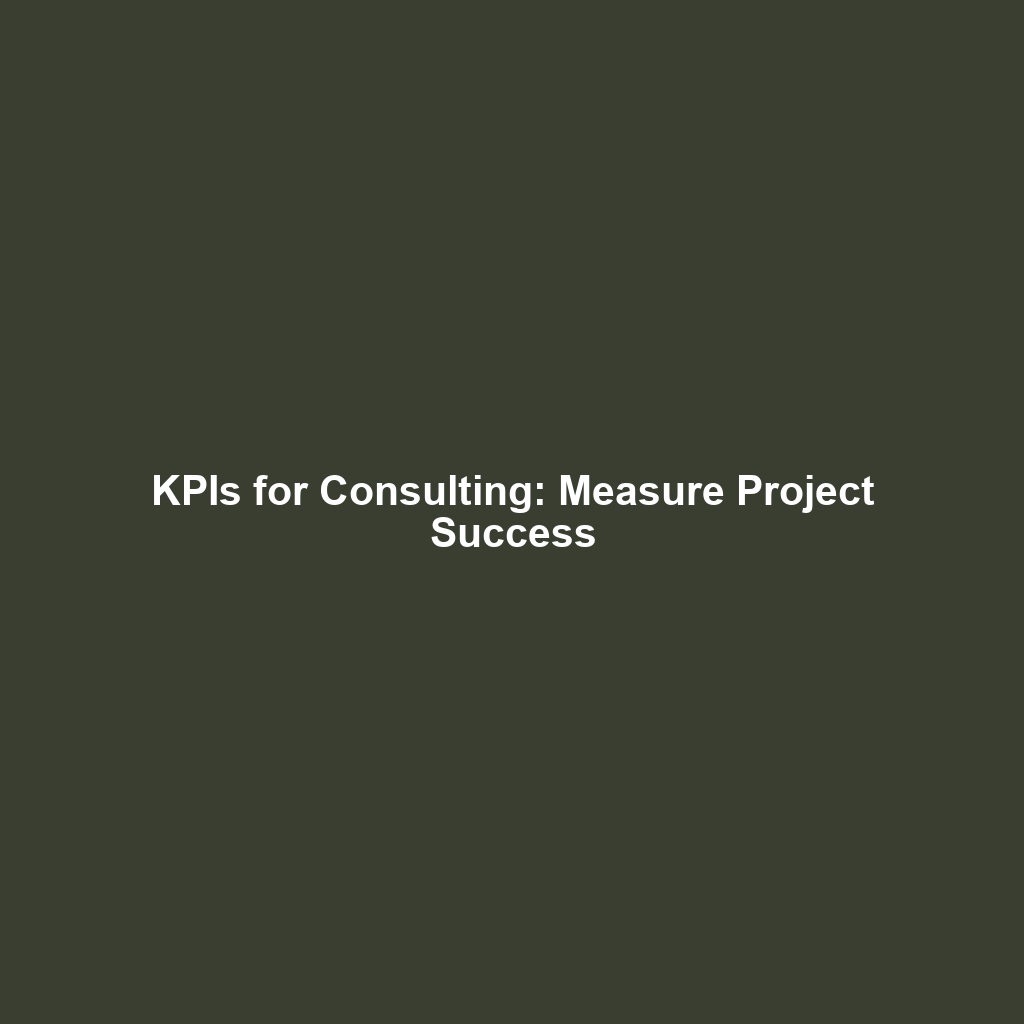Strategic consulting projects are designed to solve complex business problems and drive significant improvements. But how do you know if a project is truly successful? The answer lies in carefully defining and tracking Key Performance Indicators (KPIs). This article provides a comprehensive framework for selecting relevant KPIs, establishing baseline metrics, and monitoring progress towards desired outcomes. We’ll explore real-world examples and practical applications to demonstrate the importance of KPIs in ensuring accountability and delivering tangible results.
The Critical Role of KPIs in Strategic Problem-Solving
KPIs are more than just metrics; they are vital signs that indicate the health and progress of a strategic initiative. They provide a clear and objective way to measure the effectiveness of implemented solutions and ensure alignment with overall business objectives. Without well-defined KPIs, consulting projects can easily drift off course, leading to wasted resources and unrealized potential.
Consider a scenario: A retail company hires a consulting firm to improve its supply chain efficiency. Without specific KPIs, the project might implement new technologies or processes without actually impacting key areas like inventory costs or delivery times. By defining KPIs such as “Inventory Turnover Rate” and “Order Fulfillment Time,” the consulting team can focus their efforts on initiatives that directly contribute to measurable improvements.
Key Insight: KPIs provide a data-driven basis for decision-making and performance evaluation, ensuring that strategic consulting projects deliver measurable value and impact.
Why KPIs Matter: Accountability and Results
- Accountability: KPIs establish clear expectations and hold both the consulting team and the client accountable for achieving specific results.
- Results: They provide a tangible way to measure the impact of the project on key business outcomes.
- Alignment: KPIs ensure that the project aligns with the client’s overall strategic objectives.
- Transparency: Tracking and reporting on KPIs provides transparency into the project’s progress and performance.
- Continuous Improvement: KPIs enable continuous monitoring and adjustment of strategies to optimize results.
A Framework for Selecting Relevant KPIs
Choosing the right KPIs is crucial for effective performance management. The selection process should be aligned with the specific goals and objectives of the strategic consulting project. Here’s a framework to guide you:
1. Understand the Business Objectives
The first step is to thoroughly understand the client’s overall business objectives. What are they trying to achieve? What challenges are they facing? What are their priorities?
For instance, if a client’s objective is to increase market share, relevant KPIs might include “Market Share Percentage,” “Customer Acquisition Cost,” and “Customer Lifetime Value.”
2. Identify Critical Success Factors
What are the key factors that will determine the success of the project? These are the areas where the project needs to make a significant impact in order to achieve the desired outcomes.
For a project focused on improving customer satisfaction, critical success factors might include “Reduced Customer Churn,” “Improved Net Promoter Score (NPS),” and “Increased Customer Retention Rate.”
3. Select SMART KPIs
Choose KPIs that are SMART:
- Specific: Clearly defined and focused.
- Measurable: Quantifiable and trackable.
- Achievable: Realistic and attainable.
- Relevant: Aligned with business objectives.
- Time-bound: With a defined timeframe for achievement.
Instead of a vague KPI like “Improve Customer Service,” a SMART KPI would be “Increase Net Promoter Score (NPS) by 10 points within 6 months.”
4. Consider Leading and Lagging Indicators
Leading indicators are predictive measures that indicate future performance. Lagging indicators are outcome-based measures that reflect past performance.
For example, in a sales improvement project, a leading indicator might be “Number of Sales Calls Made per Week,” while a lagging indicator would be “Monthly Sales Revenue.”
Balancing both leading and lagging indicators provides a more complete picture of the project’s progress and allows for proactive adjustments to optimize performance.
5. Limit the Number of KPIs
Avoid overwhelming yourself with too many KPIs. Focus on a small number of critical indicators that truly reflect the project’s success. A manageable set of KPIs (typically 3-5) will be easier to track and manage effectively.
Key Insight: Effective KPIs are SMART, balanced between leading and lagging indicators, and limited in number to ensure focus and manageability.
Establishing Baseline Metrics and Targets
Once you’ve selected your KPIs, the next step is to establish baseline metrics and targets. This involves gathering data on the current performance of the KPIs and setting realistic goals for improvement.
1. Gather Baseline Data
Collect historical data for each KPI to establish a baseline. This will provide a starting point for measuring progress. Ensure the data is accurate and reliable.
If the KPI is “Inventory Turnover Rate,” gather historical data on inventory levels and sales for the past year to calculate the current turnover rate.
2. Set Realistic Targets
Set targets that are challenging but achievable. Consider factors such as the client’s resources, the project’s timeframe, and the industry benchmark.
If the baseline Inventory Turnover Rate is 4, a realistic target might be to increase it to 5 within 12 months.
3. Document Assumptions and Dependencies
Clearly document the assumptions and dependencies that underpin the targets. This will help to explain any deviations from the expected results.
For example, the target for Inventory Turnover Rate might be dependent on the implementation of a new inventory management system and improved demand forecasting accuracy.
4. Obtain Stakeholder Buy-In
Involve key stakeholders in the process of setting targets to ensure buy-in and commitment. This will increase the likelihood of achieving the desired results.
Present the baseline data and proposed targets to the client’s management team and solicit their feedback before finalizing the KPIs.
Monitoring Progress and Reporting Results
Regular monitoring and reporting of KPIs are essential for tracking progress and making necessary adjustments to the project strategy. This ensures that the project stays on track and delivers the desired outcomes.
1. Establish a Tracking System
Implement a system for tracking and monitoring KPIs on a regular basis. This could involve using spreadsheets, dashboards, or specialized software.
A simple spreadsheet can be used to track KPIs such as “Website Conversion Rate,” “Customer Acquisition Cost,” and “Average Order Value,” with columns for date, metric value, and notes.
2. Schedule Regular Progress Reviews
Conduct regular progress reviews with the client to discuss the performance of the KPIs. This provides an opportunity to identify any issues or challenges and make necessary adjustments to the project strategy.
Schedule weekly or bi-weekly meetings with the client to review the KPI dashboard and discuss any trends or anomalies.
3. Provide Clear and Concise Reporting
Present the KPI data in a clear and concise format that is easy for the client to understand. Use charts and graphs to visualize the data and highlight key trends.
Create a dashboard that displays the KPIs in a visual format, with color-coded indicators to show whether the project is on track, at risk, or behind schedule.
4. Identify and Address Deviations
If the KPIs are not performing as expected, investigate the reasons for the deviations and take corrective action. This might involve adjusting the project strategy, reallocating resources, or addressing any underlying issues.
If the “Customer Acquisition Cost” is higher than expected, analyze the marketing campaigns to identify areas for improvement and optimize the targeting and messaging.
5. Communicate Transparently
Maintain open and transparent communication with the client throughout the project. This will help to build trust and ensure that the client is fully informed of the project’s progress.
Proactively communicate any challenges or setbacks to the client and work together to develop solutions.
Key Insight: Consistent monitoring, clear reporting, and transparent communication are critical for ensuring that KPIs drive continuous improvement and deliver successful outcomes in strategic consulting projects.
Examples of KPIs for Various Consulting Projects
The specific KPIs that are relevant to a strategic consulting project will depend on the project’s goals and objectives. Here are some examples of KPIs that might be used in different types of projects:
1. Operational Efficiency Improvement Project
- KPI: Reduction in Operating Costs (Percentage)
- KPI: Increase in Process Efficiency (Percentage)
- KPI: Improvement in Throughput (Units per Hour)
- KPI: Reduction in Defect Rate (Percentage)
Scenario: A manufacturing company hires a consulting firm to improve its operational efficiency. The consulting team implements lean manufacturing principles and process optimization techniques. The KPIs are used to measure the impact of these changes on the company’s cost structure and productivity.
2. Sales and Marketing Improvement Project
- KPI: Increase in Sales Revenue (Percentage)
- KPI: Improvement in Lead Conversion Rate (Percentage)
- KPI: Reduction in Customer Acquisition Cost (Percentage)
- KPI: Increase in Customer Lifetime Value (Percentage)
Scenario: A software company hires a consulting firm to improve its sales and marketing performance. The consulting team implements a new CRM system, develops targeted marketing campaigns, and trains the sales team. The KPIs are used to measure the effectiveness of these initiatives in generating leads, closing deals, and increasing customer loyalty.
3. Customer Experience Improvement Project
- KPI: Improvement in Net Promoter Score (NPS)
- KPI: Reduction in Customer Churn Rate (Percentage)
- KPI: Increase in Customer Satisfaction Score (CSAT)
- KPI: Improvement in Customer Retention Rate (Percentage)
Scenario: A telecommunications company hires a consulting firm to improve its customer experience. The consulting team implements a new customer service training program, streamlines the customer onboarding process, and develops a customer feedback mechanism. The KPIs are used to measure the impact of these changes on customer loyalty and satisfaction.
4. Digital Transformation Project
- KPI: Increase in Website Traffic (Percentage)
- KPI: Improvement in Website Conversion Rate (Percentage)
- KPI: Increase in Social Media Engagement (Percentage)
- KPI: Reduction in IT Costs (Percentage)
Scenario: A traditional retail company hires a consulting firm to implement a digital transformation strategy. The consulting team develops a new e-commerce platform, implements a social media marketing strategy, and migrates the company’s IT infrastructure to the cloud. The KPIs are used to measure the success of these initiatives in driving online sales, engaging customers, and reducing IT costs.
Key Insight: Choosing the right KPIs is essential for accurately measuring the success of strategic consulting projects and ensuring that they deliver tangible business outcomes.
Common Challenges and How to Overcome Them
While KPIs are essential for measuring success, there are several challenges that can arise during their implementation and tracking. Here are some common challenges and strategies for overcoming them:
1. Difficulty in Defining Measurable KPIs
Challenge: Sometimes, it can be difficult to define KPIs that are truly measurable and aligned with the project’s objectives.
Solution: Use the SMART framework to ensure that the KPIs are specific, measurable, achievable, relevant, and time-bound. Break down complex objectives into smaller, more manageable components that can be easily measured. Consider using proxy metrics if direct measurement is not possible.
For example, if the objective is to “improve employee morale,” a proxy metric could be “employee participation rate in company events” or “employee satisfaction score on anonymous surveys.”
2. Lack of Data Availability
Challenge: It may be difficult to gather the necessary data to establish baseline metrics and track progress.
Solution: Invest in data collection and analysis tools and processes. Work with the client to identify existing data sources and develop new data collection methods. Ensure that the data is accurate and reliable. If data is not readily available, consider starting with a pilot program to collect data before implementing the project on a larger scale.
3. Resistance to Change
Challenge: Employees may resist the implementation of KPIs, particularly if they perceive them as a way to micromanage their work or hold them accountable for unrealistic goals.
Solution: Communicate the benefits of KPIs clearly and transparently. Involve employees in the process of selecting and defining KPIs. Ensure that the KPIs are aligned with their individual goals and objectives. Provide training and support to help employees understand how to use KPIs to improve their performance. Frame KPIs as tools for improvement, not punishment.
4. Overemphasis on Short-Term Results
Challenge: Focusing too much on short-term results can lead to neglecting long-term strategic objectives.
Solution: Balance short-term and long-term KPIs. Ensure that the KPIs are aligned with the client’s overall strategic objectives. Regularly review and adjust the KPIs as needed to ensure that they remain relevant and aligned with the changing business environment. Consider including qualitative measures alongside quantitative KPIs to capture the full picture of the project’s impact.
5. Misinterpretation of Data
Challenge: Data can be misinterpreted or used to draw incorrect conclusions, leading to flawed decision-making.
Solution: Ensure that the data is analyzed by qualified professionals with expertise in data analysis and statistics. Use data visualization tools to present the data in a clear and understandable format. Conduct regular data quality checks to ensure accuracy and reliability. Consider external benchmarking to compare performance against industry peers.
Key Insight: Addressing these challenges proactively can significantly improve the effectiveness of KPI implementation and ensure that strategic consulting projects deliver lasting value.
Conclusion
Defining and tracking KPIs is a critical component of successful strategic consulting projects. By carefully selecting relevant KPIs, establishing baseline metrics, and monitoring progress towards desired outcomes, consulting firms can ensure accountability, deliver tangible results, and demonstrate the value of their services. The framework and examples provided in this article offer a practical guide for implementing effective KPI management in strategic problem-solving initiatives.
Strategic problem-solving, augmented with the power of well-defined KPIs, empowers businesses to not only navigate challenges but also to unlock unprecedented opportunities. For organizations looking to drive transformative change and achieve measurable success, a data-driven approach guided by strategic KPIs is the key.
This article was optimized and published by Content Hurricane.


